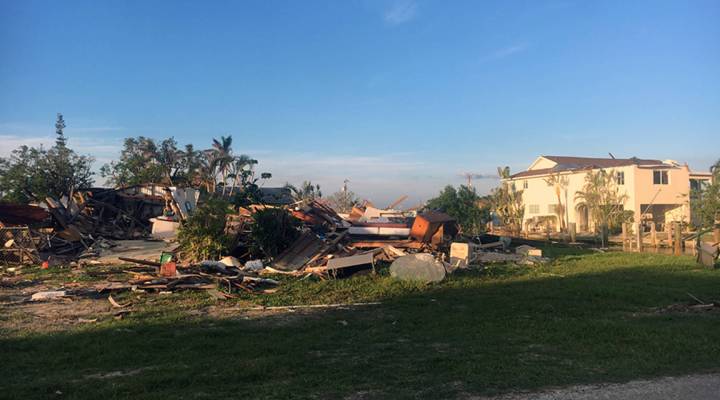
Floridians wait for help and repairs after Irma

Since Hurricane Irma slammed into Southwest Florida in September with wind, rain and flooding, more than $2.2 billion in federal government assistance has flowed to residents and businesses in the state. That includes Federal Emergency Management Agency disaster assistance grants of up to $33,300 per household for immediate emergency needs like temporary shelter, critical repairs, food and clothing; Small Business Administration low-interest rebuilding loans; and payouts to homeowners covered by FEMA’s National Flood Insurance Program.
FEMA has been hiring temporary staff, said spokesman Michael Wade, to help process the 2.6 million applications for disaster assistance filed so far by Florida households — more than one in three households statewide.
“There’s a lot of Haitian Creole population and people that speak Spanish, so we’re looking for interpreters,” Wade said.
Residents and elected officials said there were long wait times for assistance on FEMA’s phone lines in the weeks after the hurricane. Wade said those wait times have been reduced significantly. But people in storm-affected areas are still facing a long wait for repairs due to labor shortages in the state.
On Marco Island on the Gulf Coast south of Naples, where the storm came ashore, wind and rain thrashed beachfront hotels and upscale housing developments.
“We do have a sky of blue tarps, because a lot of our roofs were damaged,” said Dianna Dohm, executive director of the Marco Island Area Chamber of Commerce. She said for most homeowners, paying for repairs isn’t the problem — anyone with a mortgage is likely covered by homeowners insurance for wind and rain damage.
But she said the local unemployment rate is low — 3.8 percent as of October.
“It’s very difficult because there are just not enough construction workers down here,” said Dohm. “All of our contractors — they don’t have enough workers to get the work done. So everyone needs to be patient.”
But some locals aren’t waiting.
Steve Gober owns Stan’s Idle Hour Restaurant in Goodland, Florida, a coastal community several miles south of Marco Island. The business has been in his family for 48 years. It features outdoor seating on the water, fresh seafood and live music.
Gober said Hurricane Irma caused extensive damage to his restaurant, inside and out. He was closed for eight weeks and said he put at least $100,000 of his own money into repairs.
“You got to get open,” said Gober, “and that’s what we’ve done — at first just opening on the weekends. I had a lot of help from friends to help me rebuild, and a lot of staff. I called the staff and said, ‘Hey, you want me to reopen? Get down here and help me so I can make money and pay you.’”
Gober said he didn’t have insurance to cover his repairs or lost revenue. And he didn’t apply to FEMA or the Small Business Administration for assistance.
| Florida’s uneven recovery from Hurricane Irma |
| The business of disaster: How does the U.S. spend relief money? |
| Why disaster recovery is a long, slow process |
People who come to one of the disaster recovery centers that remain open in the state are often confused by the regulations that govern federal assistance, said Edith Lovell, a FEMA applicant assistant. She was brought in from Texas several weeks after Hurricane Irma to work at centers in Gainesville, St. Augustine and Naples. The deadline for applying to FEMA was Nov. 24. Of the 2.6 million Florida households that had applied for FEMA disaster assistance as of the first week of December, 751,837 had been approved for payment by the agency, according to Wade. He said many of the applications that are still pending require further documentation or require the applicant to take other steps, like apply for an SBA loan as well.
“The most frustrating thing for people is they seem to think that we should be like an insurance company and do the repairs on everything,” Lovell said. “We can’t do that. We weren’t set up to completely restore the house. Congress set us up to be just like a Band-Aid, to make you functional, safe and secure.”
Lovell said working for FEMA in these conditions can be difficult — dealing with frustrated storm victims who may still be living in wind- or flood-damaged homes, trying to get the paperwork right and worrying about whether they’ll get government financial help. “I always listen to someone when they’re angry and I always tell them they have every right to be angry,” Lovell said. “I know that they’re not angry at me, they’re just angry with their situation. Then I say, ‘OK, let’s see what we can do to fix that.’”
There’s a lot happening in the world. Through it all, Marketplace is here for you.
You rely on Marketplace to break down the world’s events and tell you how it affects you in a fact-based, approachable way. We rely on your financial support to keep making that possible.
Your donation today powers the independent journalism that you rely on. For just $5/month, you can help sustain Marketplace so we can keep reporting on the things that matter to you.












